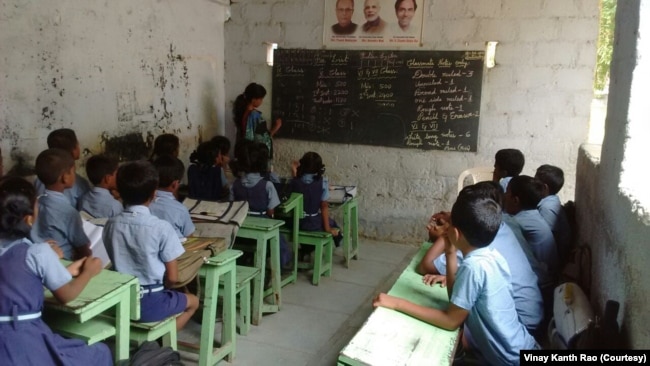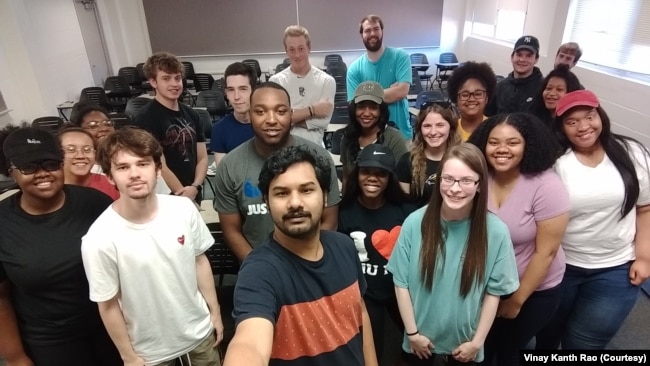私がもっとも気になったのが、”アメリカでは数学だけでなく、重要な数学の教え方も学べることを知りました。”の件です。
一体なんなの? 数学苦手な私は長年数学を愛したいと思っています。
「世界は数字でできている」野口悠紀雄著
また、読み直そっと!!
VOAで英語を学びましょう!!
数学教授がインドとアメリカの教授法をつなぐ(和訳)
Math Professor Connects Teaching Method in India, US
Dec,18,2022
インドで育ったヴィナイ・カント・ラオさんは、数学が大好きで、いつか数学を教えたいと思っていました。
インド、ワランガルの国立工科大学で数学の修士号を取得した後、米国コロラド大学の博士課程に入学しました。コロラド大学で数学の授業をしていたとき、ある生徒から質問を受けたことが、彼にとって数学の転機となったのです。
ある生徒がちょうど私に、聞いてきたのです:’なぜ私はこれを学んでいるのですか?’と。この質問はおそらく25年間…自分自身に問うてこなかった質問です。そのとき私は、気づいたのです、そうよ—もし何かを学ぶのなら、それを使えるようにならなければいけないと。ですよね?もしくは少なくとも、その先には、それは応用が利かなければなりません。
ヴィネイさんはまた、アメリカでは数学だけでなく、重要な数学の教え方も学べることを知りました。
2016年、彼は南ミシシッピ大学にtransferre編入し、科学・数学教育センター、CSME、で数学教育を学びました。彼は、数学の指導を改善する方法を模索し、開発することができたのです。
ヴィネイさんはこう言います:「その決断が私の人生を変えたのです。」と。
ヴィネイさんは、visualsイメージ画像、コンピュータゲーム、そして探究型指導の活用を拡大しました。探究型とは、教師の説明を聞くだけでなく、生徒が教師の助けを借りながら一緒になって質問に答えるというものです。
CSMEの前ディレクターであるシェリー・ヘロン氏は、サザンミシシッピ校でのヴィネイさんの指導者でした。大学のホームページの記事で、ヴィネイさんのことを語ってます:「これほどやる気、創造性、知性、労働意欲を持ち、これほど多く、これほど多様な製品を生み出せる学生を見たことがありません。」と。
インドでのアクティブラーニング
2018年、ヴィネイさんはインドの学生や教師に探究型教授法を届けるため、ワランガルでアクティブ・ラーニング研究所を設立しました。彼はそれを支援するために15,000ドルを集め、COVID-19の大流行で進捗が遅くなる前に何度もワランガルへ足を運びました。
ヴィネイさんは、インドでは数学教育は競争が激しく、学生は "圧力釜 "の中にいるような感覚に陥ると言っています。インドでは、エンジニアや医者になることがキャリアの成功をつかむ唯一の方法だと考えている人が多いのです。そのため、数学を勉強するときに余計なプレッシャーを感じてしまい、その科目が嫌いになってしまうことが多いのです。
アクティブラーニング研究所で、ヴィネイさんはこの状況を変えようとしています。まず、彼は通常の60〜100人のクラスに比べて少人数制で、授業を行います—1クラス20人程度—。2つ目は、生徒の学習意欲を高めるために、質問型の授業を行います。そして、工学以外の分野で働く人を授業に招き、数学に関連した職業が他にもたくさんあることを紹介するのです。
アメリカ人とインド人の生徒の違い
ヴィネイさんは現在、ミズーリ州セントルイスにあるミズーリ大学セントルイス校で教鞭をとっています。彼は最近、米国とインドにおける数学教育の違いについてVOAに語りました。インドの学生は一般的に数学のfoundations基礎がしっかりしていると言います。彼らは暗記や問題解決に長けています。しかし、アメリカの学生は、数学とその応用とのつながりを示すことに長けています。また、アメリカではクラスの人数が少ないので、ヴィネイさんは生徒により多くの1対1の手助けをすることができるのです。
ラディア・ファリド さんは最近、ミズーリ州セントルイスでヴィネイさんの授業を2回受けました。彼女は、ヴィネイさんは”実世界のアプリケーションをたくさん使って、学習しているコンセプトを視覚化する手助けをしてくれました。その例として、アニメーションやゲーム開発などが挙げられる”と言っています。
次の目標は?
ヴィネイさんは長期的に、より多くの人が数学を楽しく学べるようにしたいと考えています。人気のあるLove of Physicsトークのように、ビジュアルを使い、数学の応用を示す教材をもっと作ろうと考えています。また、高校の数学の先生が教材を作るのに役立つソフトを作りたいと考えています。
※Love of Physics (とってもおもしろいですよ! ぜひご覧ください。)
しかし、おそらく彼の最大の目標は、米国のコミュニティ・カレッジのモデルをインドに導入することでしょう。コミュニティカレッジでは、自動車修理や情報技術など、さまざまな職業に就くためのスキルを学びます。
学生は通常、2年以下の学習期間で訓練を修了することができます。そしてそれは、大学課程に入学できないインドの人々の機会を増やすことになるでしょう。
Math Professor Connects Teaching Method in India, US
Growing up in India, Vinay Kanth Rao loved math and knew that he wanted to teach math someday.
After earning his master’s degree in mathematics from the National Institute of Technology in Warangal, India, he entered the doctoral program at the University of Colorado in the United States. While Vinay was teaching a math class at Colorado, a student asked him a question that became a turning point for him about the subject.
One of the students just asked me: ‘Why am I learning this?’ Now, that is the question I did not ask myself for probably 25 years… That was when I realized, OK—if you’re learning something, you should be able to use it, OK? Or at least, down the line, it should be applicable.
Vinay also learned that in the U.S. he could study not only math but, importantly, ways to teach math.
In 2016 he transferred to the University of Southern Mississippi, where he studied mathematics education at the Center for Science and Mathematics Education, or CSME. He was able to explore and develop ways of improving mathematics instruction.
Vinay said: “That decision changed my entire life.”
Vinay brought increased use of visuals, computer games, and inquiry-based instruction to his teaching. Inquiry-based means students work together to answer questions with some help from a teacher rather than only listening to a teacher’s explanation.
Sherry Herron, a former director of CSME, was Vinay’s mentor at Southern Mississippi. She talked about Vinay in an article on the university website: “I have never seen a student with such motivation, creativity, intelligence, and work ethic, and who can produce so much and so many diverse products.”
Active learning in India
In 2018, Vinay founded the Active Learning Institute in Warangal to bring the inquiry-based teaching method to students and teachers in India. He raised $15,000 to support it and traveled to Warangal several times before the COVID-19 pandemic slowed progress.
Vinay said that in India, mathematics education is so competitive that students feel like they are in a “pressure cooker.” Many people in India think that becoming an engineer or a doctor are the only ways to find career success. This makes them feel extra pressure when they study math, and it often makes them dislike the subject.
At the Active Learning Institute, Vinay is trying to change that. First, he teaches smaller groups of students—about 20 in a class—compared to normal classes with 60 to 100 students. Second, he uses inquiry-based methods to help the students learn. Then, he brings workers in areas besides engineering to his classes to show that there are many other math-related careers.
Differences between American and Indian students
Vinay currently teaches at the University of Missouri-St. Louis in St. Louis, Missouri. He recently talked to VOA about the differences between mathematics education in the U.S. and India. He said Indian students generally have stronger foundations in math. They are better at memorizing and solving problems. But American students are better at showing the connection between math and its applications. And smaller class size in the U.S. means Vinay could give his students more one-on-one help.
Radia Farid recently took two classes with Vinay at Missouri-St. Louis. She said Vinay “used a lot of real-world applications, and those would help you visualize the concepts that we were learning. And examples would include animation and game development.”
What’s next?
Long term, Vinay wants to help more people enjoy learning math. He plans to create more teaching materials that use visuals and show the applications of math like the popular Love of Physics talks. He also hopes to create software to help high school math teachers with preparing teaching materials.
But, perhaps, his biggest goal is to bring the U.S. model of community colleges to India. Community colleges teach students skills for different careers, such as automotive repair or information technology.
Students usually need two years of study or less to complete their training. And that will increase opportunities for people in India who cannot enter university programs.
Words in This Story
transfer -v. to move something or someone from one place or category to another
visuals -n. images used to in designs or displays
mentor -n. a person who gives special instruction and guidance to another, commonly for training in a specific subject or type of work
motivation -n. a strong desire to do something
ethic -n. a value or moral belief that influences behavior
diverse -adj. having a lot of variety or different kinds
foundation -n. a base upon which other things depend or may be built
concept -n. an idea or abstract principle
animation -n. visual effects in which drawings or cartoons appear to be in motion
opportunity -n. the chance or possibility of doing something one wants to do


